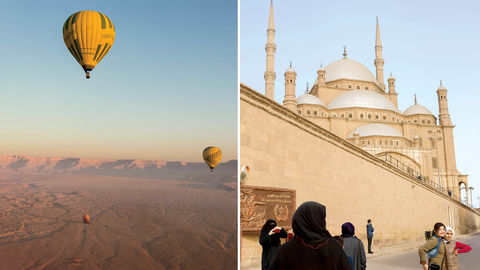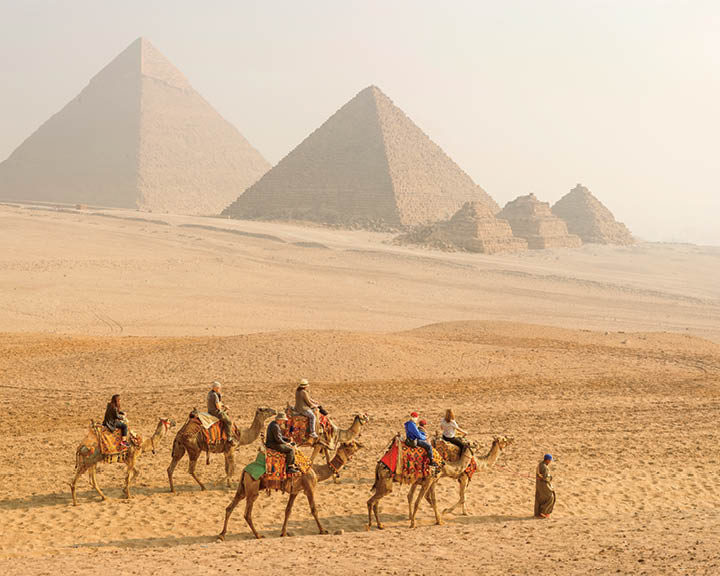
After almost a decade of political upheaval, more stable times—and visitors—are returning to Egypt. And while the streets of Cairo may still resound with speculation over the future, the country’s ancient past remains vividly, gloriously alive in the monuments of Giza, Luxor, and Aswan. Text by Aatish Taseer; Photographs by Simon Roberts

Until that first morning in Cairo, I had always felt the art of ancient Egypt to be out of reach. I could admire its scale, of course, and its impassive beauty. Like most New Yorkers, I had delighted at the sight of the Temple of Dendur, all lit up in the Metropolitan Museum of Art, as I made my way home through Central Park. But for art to really live, it cannot be mere background. One has to find a way to understand its spirit, to inhabit the world it came from. To me, the culture of ancient Egypt had always seemed so heavily caricatured, it hardly felt real. And I’d struggled to get my head around its mind-boggling antiquity. Was it really possible that as many centuries separate Alexander the Great from the Pyramids of Giza as separate us from him?
But on that bright December morning, at the new Grand Egyptian Museum in Giza, just west of Cairo, something changed in me forever. Finding myself in proximity to objects now banal, now wondrous, the art of ancient Egypt ceased to be remote or cartoonish. Here was Tutankhamun’s papyrus chair; there were ushabti, or funerary figurines, in various enticing shades of blue. In another room were slim-limbed funerary beds, their gold leaf still intact. One had cat-faced Sekhmet on its posts, the other the sky cow Mehet-Weret, with black trefoils decorating its gold skin. It was all so near, so intimate. Even the masked world of the pharaohs did not seem out of reach once I’d just stood inches away from Tutankhamun’s underwear—a great linen thong stained brown, not through any fault of his own, but by 33 centuries of oxidation.

The museum, which was built at a cost of $1.1 billion, is pharaonic. No other word captures the 5,000-yearlong Egyptian tradition of building monuments on a scale that defies all imagination. In modern times, Egypt hasn’t lost its fondness for pharaonic scale. There’s former president Gamal Abdel Nasser’s dam at Aswan, which created one of the world’s largest man-made lakes and forced the relocation of the entire temple complexes at Abu Simbel and Philae; a new, as-yet-unnamed, capital city under construction 45 kilometres east of Cairo; and now this grand museum, slated to open in 2020. The building is so vast that even the 39-foot-tall colossus of Ramses II, which once towered over Ramses Square, in the centre of the city, is a mere bauble in its atrium.
Designed as a recumbent pyramid of glass, stone, and steel, the new museum sits in the shadow of the ancient Pyramids, trying, by a trick of design and perspective, to muscle into their good graces, like some neglected halfsibling. It is too early to say what the galleries will feel like once they are complete, or what the sweeping views of Giza’s royal monuments will do to edify the place once the construction is finished and the sight lines are clear. What I can say is that in the various conservation laboratories that my husband and I visited—stone labs and wood labs, wet labs and dry labs—we saw up close some of what the museum will contain. And it was marvellous.

We were in Egypt at the end of what some were calling “the seven bad years.” The Arab Spring of 2011 had come and gone, and the overthrow of Hosni Mubarak, who had ruled Egypt despotically for three decades, had led to years of tumult in which this tourist- dependent country had been starved of visitors. By the time we arrived, Egypt had been delivered into the hands of yet another strongman, Field Marshal Abdel Fattah el-Sisi. And though terror attacks remained a problem, the bargain had brought relative stability and security to the country. Ambitious infrastructure projects were afoot. Visitors were returning in great numbers, and we were among them.
In Cairo, in addition to the usual sightseeing, we hoped to get a sense of the great human drama that has unfolded in the streets of this heaving megacity. Cairo has a fabled intellectual life, and I wanted to hear its voices, for it seemed to me that to travel merely for the sights in a place recovering from so great an upheaval was to travel blind. After Cairo, we would fly to Aswan and embark on that most classical of all journeys: a boat trip on the Nile, threading a course north to Luxor, seeing temple after ancient temple. I had spent many years visiting other wonders of the ancient world, but the prospect of seeing what had been wondrous, even to the ancients, was exhilarating.

“Cairo is jazz,” Omar Robert Hamilton wrote in The City Always Wins, a novel set during the Arab Spring. It is “all contrapuntal influences jostling for attention, occasionally brilliant solos standing high above the steady rhythm of the street. Forget New York, the whole history of the world can be seen from here.” At first, all I saw was a vast, dun-colored sweep of dimly lit buildings. The congestion of Cairo was so extreme that it seemed to subsume even the Pyramids, let alone the later works of Fatimids and Ottomans. But, gradually, era by era, like a perfume breaking into its constituent elements, the city began to reveal itself—now as a place of seedy bars and broken-down aristocrats, now as a living museum, in which it was possible to wander along a street and see an unbroken arc in which age after age of Islamic architecture is laid out. Crumbling European buildings, their façades heavy with dust, sat alongside Abbasid arcades. There were Ottoman hammams, with smooth, dichromatic ablaq masonry, and Mamluk mosques with stalactites in their arches.
In other places, the further back you go in time the less the past is able to speak. Not Egypt. The glories of its past seem, if anything, to speak more eloquently from that uncharted place in history where even things we consider extremely old—figures such as Zoroaster, the Buddha, and Confucius, say—are still a thousand years down the road. I have been to Palmyra and Persepolis, Pompeii and Pergamon; I’ve seen the library of Celsus at Ephesus and wandered the ruins of Apamea. I say this not to boast, but to make a simple statement of fact: there is nothing like Egypt. Nothing so old, nothing so intact, nothing so beautiful.

The Temple of Philae, which is near Aswan and accessible only by boat, was my first Egyptian temple. Our guide, Baher, was a huge, bearlike Copt—a word that today is used to describe Egypt’s Coptic Christian community of some four million people but is, in fact, derived from the Greek word Ægyptos and means ‘Egyptian’ before it means ‘Christian’. Baher told us the temple at Philae was something of a baby—both in size and in age, being a mere 23 centuries old. It was moved when Nasser built his dam to a small island, now overgrown with elephant grass. La Chanson de Prévert by Serge Gainsbourg played somewhere on the shore, where slim-limbed Nubians sold souvenirs. The entrance pylon of Philae, with its delicate tracery dedicated to Goddess Isis, rose out of the waters, and I was in love.
Baher was at pains to remind us that this was a Ptolemaic temple—an example of ancient Egyptian culture inspiring the Greek imagination. He felt it lacked the gorgeous simplicity of pure Egypt, of which Queen Hatshepsut was a cynosure. Later, at Luxor Temple, when I saw Hatshepsut’s columns, the tops of which are modelled on closed papyrus fl owers wrapped in palm leaves, I came to agree with Baher. Like the acanthus serving as the model for Corinthian columns, they were sublime, and totally true to their place. And yet, Philae was my first temple, and there is nothing in the world to compare with that virgin glimpse of sunlight on sandstone, diamonds strewn over the river, and the endless blue of an Egyptian sky.

We sailed on to Kom-Ombo, the temple dedicated to both Sobek, the crocodile god, and Horus, the falcon god. Then Edfu, then Luxor. The Oberoi Philae lulled us. Despite the execrable quality of the local wine—imported wine is prohibitively expensive in Egypt—we developed a tolerance for Sultanine Blanche. The food, now biryani, now a baked Nile perch served with khalta rice, was full of variety. We made friends with the Johnsons, an American family of four. Mr Johnson worked at a travel firm. Egypt, incidentally, was his clients’ number one destination in 2018.
Of the many impressions that burned themselves on my mind, none were more powerful, beyond the Pyramids and the Luxor Temple at night, than those of the tombs. I don’t imagine I will ever feel again what I did, walking down that sloping ramp into Tomb KV9— built for Ramses V and VI —in the Valley of the Kings. All around me were scenes of isfet, an ancient Egyptian concept of chaos, imbalance, and injustice—a world turned upside down in which, as in a David Lynch film, red figures hang like clothes from a line, with their arms bent back. On the ceiling, a snaking yellow Nut, goddess of the sky, made a breakfast of the stars at dawn and swallowed the sun at night.

Twenty-four hours later we were back in Cairo. We had dinner with Egyptologists in an apartment in Zamalek, a bourgeois neighbourhood on an island in the Nile. We talked of crocodile mummification and of how much we loved Sekhmet, goddess of war—“She’s tough, she takes no shit from nobody,” said one Egyptologist. Then the conversation turned, as it inexorably will in Cairo, back to revolution. Our hostess had also witnessed the euphoria of 2011, but her family was from Pakistan—another army in search of a state—and she knew better than to trust the romantic outpourings of humanity. “What will you replace him with?” she recalled asking her Egyptian friends at the time, and received silence for an answer.
The next day, the plane rose and Egypt faded below us, the Nile a meandering vein of green through a solid block of yellow onyx. There was no doubt that the failure of the Arab Spring had cast a pall over this country, which, being the largest in the Arab world, was the flag-bearer of its hopes and expectations. Yet I couldn’t help feeling that Egypt had also been lucky. From the blowing up of the Bamiyan Buddhas in Afghanistan in 2001 to the willful defacement of Syrian antiquity, so much of what had stood for centuries has been destroyed in our time. Egypt, though its hopes of freedom were disappointed, was still intact. Sooner or later, the spirit of Tahrir would be resurrected, and who knew what boisterous future it would bring? For now, flying north, I felt grateful to have seen what history had bequeathed in Egypt—grateful, too, that seven bad years had spared what 5,000 had so painstakingly preserved.
The Classic Egypt Tour
Begin your trip with a stay in Cairo, from which you can visit the Pyramids of Giza. Then fly to either Aswan or Luxor to set off on a cruise along the Nile.
Getting There
EgyptAir flies nonstop from Mumbai to Cairo.
Cairo
Make the Nile Ritz-Carlton (doubles from INR 17,008) your base in the Egyptian capital. Though just a stone’s throw from downtown, its riverbank location provides a peaceful respite from the city. Visit Cairo’s Islamic quarter and its Khan el-Khalili bazaar, and spend at least a day in nearby Giza to see the Pyramids and the Great Sphinx (and, as of 2020, the Grand Egyptian Museum).
Aswan
Cruise the Nile on the Oberoi Philae (five-day trips from INR 61,938 per person), a luxurious 22-cabin vessel that stops near several important ancient sites, including the Nubian Museum, the High Dam, and the Philae Temple. Cruises can begin in either Luxor or Aswan, both of which are a short flight from the capital. Sailings out of Aswan allow you to see the sites in the order they were built, and generally have better availability.
Luxor
You’ll want to spend at least a day visiting the Valley of the Kings. Luxor Temple and the Valley of the Queens, the home of Queen Nefertari’s tomb, are also unmissable.
Tour Operator
Malaka Hilton designs private itineraries across Egypt with Admiral Travel International (10-day trips from INR 3,82,684 per person). She can arrange a reception at the Pyramids or a private tour of the new Grand Egyptian Museum at Giza, among other once-in-a-lifetime experiences.
Related: The Alternate Egyptian Guide For Those Who Don’t Tread The Mainstream










